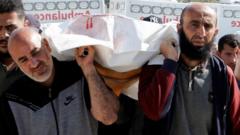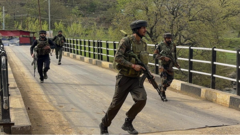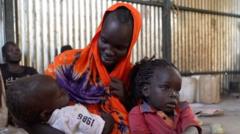The ongoing conflict in Gaza has led to a staggering reported death toll of over 51,200 Palestinians, a figure the Hamas-run health ministry defends against Israeli claims of manipulation and exaggeration. As families grapple with the loss of loved ones, the methods of data collection for fatalities have come under scrutiny, igniting debates over transparency and the accuracy of reported numbers.
Gaza's Health Ministry Responds to Death Toll Controversy Amid Ongoing Conflict

Gaza's Health Ministry Responds to Death Toll Controversy Amid Ongoing Conflict
The Hamas-run ministry defends its reported casualty figures while Israel raises questions about their accuracy and integrity.
In a grim scene at al-Shifa Hospital in Gaza City, Alam Hirzallah mourns the loss of his cousin's family, killed in an Israeli shelling. With the death of 51,266 Palestinians reported since the war's escalation, including a significant number of children, the health ministry lists are vital for international agencies and media. However, Israel asserts the figures lack credibility and are potentially skewed for propaganda purposes, especially as they do not separate civilian casualties from those involved in armed groups.
In recent weeks, discrepancies have surfaced, with some 3,000 names removed from official fatalities lists, prompting concerns about the transparency of the reporting process. Gaza health official Zaher al-Wahidi spoke to BBC, denying the notion of deceit, instead labeling the removals as a part of ongoing verification efforts to ensure the figures accurately represent the casualties. As methods for registering deaths have evolved through the chaotic conditions of ongoing hostilities, many names submitted through online forms were later found to be inaccurate or mislabeled.
The health ministry's statistics have been compiled through a centralized system that tracks deaths arriving at hospitals. Yet, ongoing conflict and the targeting of medical facilities have complicated these efforts. In the face of these challenges, officials argue started a judicial committee to verify claims and ensure accuracy, but skepticism remains from various stakeholders regarding the integrity of the data.
Diverse analyses indicate that while mistakes are common in such tumultuous circumstances, critics suggest these adjustments reveal systemic issues in the reporting process. While some analysts contend that recent nationalizations may lend to increased clarity, the overall conditions remain dire with substantial loss of life reported among both combatants and civilians alike.
International journalists have been restricted from independently verifying the figures, further complicating the understanding of the conflict and its toll. In the interim, as both sides remain entrenched, the debate surrounding the accuracy of casualty figures reflects broader issues of accountability and the complex realities of warfare in the region.
As the violence continues without an apparent resolution, the need for reliable data and pathways for humanitarian support grows ever more pressing, highlighting the ongoing plight of those caught in the conflict.
In recent weeks, discrepancies have surfaced, with some 3,000 names removed from official fatalities lists, prompting concerns about the transparency of the reporting process. Gaza health official Zaher al-Wahidi spoke to BBC, denying the notion of deceit, instead labeling the removals as a part of ongoing verification efforts to ensure the figures accurately represent the casualties. As methods for registering deaths have evolved through the chaotic conditions of ongoing hostilities, many names submitted through online forms were later found to be inaccurate or mislabeled.
The health ministry's statistics have been compiled through a centralized system that tracks deaths arriving at hospitals. Yet, ongoing conflict and the targeting of medical facilities have complicated these efforts. In the face of these challenges, officials argue started a judicial committee to verify claims and ensure accuracy, but skepticism remains from various stakeholders regarding the integrity of the data.
Diverse analyses indicate that while mistakes are common in such tumultuous circumstances, critics suggest these adjustments reveal systemic issues in the reporting process. While some analysts contend that recent nationalizations may lend to increased clarity, the overall conditions remain dire with substantial loss of life reported among both combatants and civilians alike.
International journalists have been restricted from independently verifying the figures, further complicating the understanding of the conflict and its toll. In the interim, as both sides remain entrenched, the debate surrounding the accuracy of casualty figures reflects broader issues of accountability and the complex realities of warfare in the region.
As the violence continues without an apparent resolution, the need for reliable data and pathways for humanitarian support grows ever more pressing, highlighting the ongoing plight of those caught in the conflict.





















